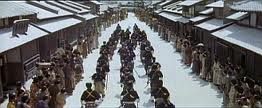Movie Review: Chushingura (The 47 Loyal Ronin) (1962)
As mentioned in my previous reviews of book and comic book versions, the tale of the forty-seven ronin is one of Japan’s great stories, based on true events. Briefly, in 1701, Lord Kira provokes Lord Asano into breaking the rules of the Shogun’s court, a crime that can only be expiated by ritual suicide. Asano’s samurai followers are immediately made ronin (masterless), and forbidden to avenge their master’s honor.
Several of the ronin decide to defy the shogunate decree, but Lord Kira is well aware of the danger, and his powerful relatives have supplied him with bodyguards to protect against retaliation. Oishi, leader of the ronin, comes up with a plan to put Kira off his guard, but it will take over a year to complete…
The 1962 film version is in color, and big-budget by Japanese standards. The early part of the story goes more into Lord Kira’s motivations; while he has a high rank, his holdings are small and impoverished. Asano is prosperous thanks partially due to his province’s salt farms. Kira tried to convince Asano to provide salt farming advice, but Asano refused on the grounds that the secret of their success was a proprietary family process.
In addition, Kira is fully invested in the quid pro quo method of doing business in the shogunate. You give expensive gifts to people or do them favors, and in exchange they do things for you. Lord Kira is guided by his principles of greed and lust, money and women are the most important things in his life. At one point, he even hints that his wife should offer herself to the Shogun to earn him political favor. (She is clearly not impressed.)
By contrast, Lord Asano hates the bribery system and the corruption it engenders, and points out that laws have been passed against such behavior, that he intends to follow. While he is aware that he needs Lord Kira to instruct him in court etiquette lest he offend the Emperor’s envoys, Asano refuses to compromise his principles, even though this angers Kira.
You might compare it to Mr. Smith Goes to Washington, and the conflict between Jimmy Stewart’s young, idealistic senator and the corrupt senior senator.
After Asano’s death, the story turns to the ronin, and how each of them copes with issues of honor, sacrifice and their conflicting emotions. Meanwhile, Kira shows cowardice and openly mocks the traditional samurai virtues.
This is a long movie, clocking in at just under three and a half hours. Thankfully, there’s a clearly marked stopping point between “Blossoms” and “Snow” that home viewers can use as a good time for intermission. While the pacing is deliberate, there are no wasted moments.
This movie has a strong cast, the most familiar to Western audiences is probably Toshiro Mifune, who has an extended cameo as one ronin’s drinking buddy. He seems to have been added just for the box office; compare to how Keanu Reeves was written to take over the whole film in the 2013 version.
Content warnings: Although none of the suicides in the film is shown directly on camera, the plotline does revolve around the use of suicide as a way of maintaining or redeeming one’s honor, and several people die in combat, particularly in the climatic battle. (One old woman is also accidentally killed in a subplot.)
Lord Kira peeps at a woman’s bare back and creepily embraces one of his maidservants, he’s clearly forcing himself on them by his own admission. Oishi does a convincing job of pretending to enjoy himself in the red light district. No on-screen sex or nudity, though. Oh, and several men are seen in period-appropriate skimpy loincloths, going about their work.
Overall, this is a classic film and well worth looking up. See my review of a comic book version here: http://www.skjam.com/2013/09/30/comic-book-review-47-ronin/ and a literary version here: http://www.skjam.com/2013/07/02/book-review-the-47-ronin/


